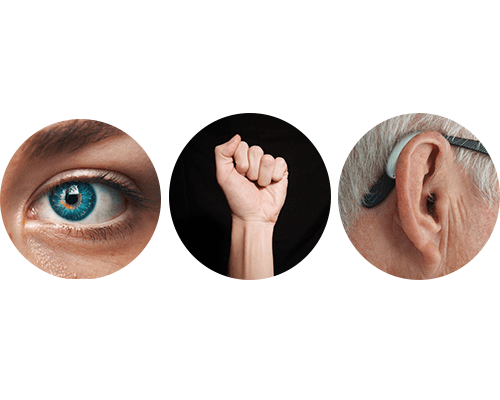
Building Rapport Through Language
When we talk, we need to think and access information at the same time. We do this using one or more sensory system, referred to as visual, auditory or kinaesthetic. By carefully listening to others, we can talk in ‘their’ language and make it easier for them to understand us, and in turn, to feel understood, helping build rapport.
1. A Sensory Systems Checklist
A person may be Visual if they…
- ✓ Are well organised
- ✓ Value appearance
- ✓ Hate being interrupted, but do it themselves
- ✓ Excel at grammar and spelling
- ✓ Like new places
- ✓ Are creative
- ✓ Talk quickly
- ✓ Value eye-contact
- ✓ Are impatient
- ✓ Enjoy the cinema, photography, interior design
- ✓ Like to holiday in a new place and take in the local colour
- ✓ Use the following type of words or phrases quite often in their speech/e-mails:
- See, look, observe, imagine, view, brilliant, scene, clear, vivid, obvious
- Things are looking up, look forward to it, see you soon, I get the picture, I see what you mean
They may be Auditory if they…
- ✓ Like conversation
- ✓ Enjoy listening
- ✓ Like to hear about facts and figures
- ✓ Like to be told precisely what to do
- ✓ Are attracted towards numerical-type jobs
- ✓ Excel on the ‘phone
- ✓ Get a buzz from organising things
- ✓ Prefer a quiet environment when trying to concentrate…or maybe music playing softly in the background
- ✓ Talk to themselves when thinking
- ✓ Enjoy listening to or playing music or singing
- ✓ Like lectures and concerts
- ✓ Use the following type of words or phrases:
- Hear, sound, talk, speak, listen, sing, noisy, tone, volume, explain, loud, ring, call, tell, dialogue
- In tune with, music to my ears, we’ll talk soon, I hear what you are saying, that rings a bell, that sounds good
Sticky Learning ® is 7 times more effective than 1-day training courses. Plus, you will get a Chain of Evidence proving your Return on Investment. Discover soft skills training that changes behaviours long term.

They may be Kinaesthetic if they…
- ✓ Are tactile
- ✓ Prone to sensitivity
- ✓ Enjoy company rather than being alone
- ✓ Value affection
- ✓ Enjoy your touching their arm when listening to them
- ✓ Get on with other things while listening
- ✓ Stand quite close to people
- ✓ Reach out and touch without embarrassment
- ✓ Tap an arm to get attention
- ✓ Have hobbies that appeal to their senses of taste, smell and touch
- ✓ May enjoy taking holidays in the sun, with sea and sand nearby
- ✓ Use their hands when they talk
- ✓ Have a firm, warm handshake
- ✓ Use the following types of words or phrases:
- Feel, touch, hot, push, hard, touch, solid, stuck, pressure, firm, heavy, weight
- Stay in touch, stiff upper lip, it was a blow, I was moved, it was unbearable

2. Relating to Others’ Language Preferences When Building Rapport
When you are naturally ‘in rapport’ with someone, the conversation will usually flow without too much thought. When there is little rapport – perhaps we have a difference of opinion that has caused conflict – then we need to try our best to build rapport deliberately in order to get a better outcome.
Matching the language of another person is one way to raise the chances of rapport. Be aware of the language that your colleagues use and reflect back on some of the keywords and phrases they tend to say.
Here are some guidelines to help you relate to Visual, Auditory and Kinaesthetic colleagues:
1- When communicating with Visuals:
- Use eye contact
- Use examples and analogies to help illustrate a point more clearly
- Match their high energy levels…and help them slow down when appropriate
- Give them things to hold/look at – don’t simply tell them about things
- Beware your appearance – they will be noticing it
- Recommend books for them to look at
- Consider both face-to-face and written (e.g. e-mail) communication when building rapport
2- When communicating with Auditories:
- Be as clear as possible in any explanations it is appropriate to give
- Make sure you are at least as prompt and as organised as they are
- Consider using the telephone to speak to them when building rapport
- Use the power of your voice to convey your message – body language may go unnoticed
- Recommend audiobooks for them to listen to
3- When communicating with Kinaesthetics:
- Allow them to talk about – and express – their feelings
- Give them the opportunity to describe their emotions about something in terms of how that emotion would feel if they could touch it
- Consider face-to-face meetings, rather than over the ‘phone
- Be prepared to accept needs for appropriate physical touch
- Be prepared to offer appropriate physical touch

Examples
The following are some examples of possible conversations involving Visual, Auditory and Kinaesthetic colleagues:
Visual Colleague
Colleague: The situation is looking bleak for me. I am unclear and see no light at the end of the tunnel.
You: You’re painting a dark picture right now. Imagine one way forward. What might that look like?
Auditory Colleague
Colleague: It’s her tone that annoys me. She’s trying to talk me into changing my hours. I’m not happy, I can tell you!
You: Sounds like her request is falling on deaf ears. What are the rest of the team saying about it?
Kinaesthetic Colleague – Building Rapport with Them
Colleague: I feel tied down and restrained in my current role.
You: What do you feel is holding you back?




